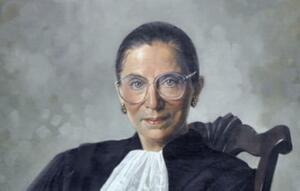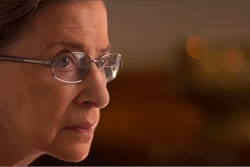Ruth Bader Ginsburg, Michigan, and Me
“The guy who funded that was a huge anti-semite, you know.”
This wasn’t the response I expected when I mentioned to a historian that I would soon be living in the Lawyers Club at the University of Michigan. The Lawyers Club, a graduate student residence dedicated to nurturing 1L students during the notoriously challenging first year of law school, is by all accounts beautiful. It has hardwood floors, sun-filled rooms, and the promise of free laundry.
Along with the gleaming hardwood and gothic architecture, anti-semitism was also apparently a key feature in the Lawyers Club’s creation.
William W. Cook, a donor who underwrote the construction of this residence, sent a note in 1924 to C.C. Little, then newly inaugurated president of the University of Michigan, advising him to refuse admission to all Jews. Interestingly, Cook’s previous gift had established the first women’s dormitory at the university.
While on the one hand, Cook’s generosity made space for (white, WASP-y) women, his anti-semitism and explicit racism (he wrote a book that encouraged his fellow country men “to make life so uncomfortable for the Jews that they cease to exist as Jews” and argued that African Americans should be made to move to New Guinea) casts a long shadow over the Law Quad at Michigan. The legal research library still bears his name.
Of course, this complicated legacy is not unique to Michigan. Many institutions are grappling with the reality that the names of racists, anti-semites, and misogynists adorn the buildings and monuments of their campuses. These men, and their legacy, looms as the institutions they funded work to educate and empower the very people these affluent men sought to oppress.
As women, we know what it means to be in spaces, both physical and ideological, that weren’t designed for us. We navigate buildings where women’s restrooms are hard to find (clearly tacked on as an afterthought); we breastfeed our children in supply closets at work; we navigate pay disparity and the entrenched perception that a man’s salary, and his time, are more important and more meaningful than ours since he is providing for his family.
When I think of Cook’s virulent desire to refuse admission to Jewish students, I have to grapple with the contradiction and complication of progress: I am training for a career in public interest law, in which I hope to increase rights and access for all people––in a setting that was built with the underlying motive to reserve those rights and that access for a select few.
In sitting with this contradiction, I am comforted and emboldened by the thought of Ruth Bader Ginsburg. William W. Cook would not have liked the notorious RBG.
In 1956, as a law student, Ginsburg attended a dinner hosted by her professor. At this dinner, the professor made each female student explain how they justified taking a spot that would otherwise have gone to a male student. Ginsburg was undeterred.
When she argued her first case, Frontiero vs. Richardson, in front of the (then) all-male Supreme Court in 1973, she had been unable to eat lunch for fear that she would throw up. But then, “Two minutes into my argument, the fear dissolved. Suddenly, I realized that here before me were the nine leading jurists of America, a captive audience. I felt a surge of power that carried me through.”
As a pioneer, Ruth graciously and quietly drove change. She did this in a setting that was intentionally designed to exclude her. She found a loophole: even though the system wasn’t built for her, the system could be made to work for her.
Countless movies, podcasts, and books have highlighted how RBG strategically used her power, and the structure of the law, to argue for feminist legal reform. She and her legal sisters-in-arms made space for women in our society, changing sexist laws so women could be regarded as citizens in their own right. Her work rerouted the course of history in a revolutionary way.
From my perspective, it is due to RBG’s skill, her strategic thinking, and her legacy that I am able to move into a beautiful room at a beautiful school that was built by a man who would not have wanted me there.
It's also due to her legacy––and to so many activists and other Jewish women who have worked to ensure that justice wasn’t a right reserved only for white Christian men––that I'm going to law school in the first place. By becoming a lawyer, I can play a part, however small, in realizing a better America. I want to be a part of the generation of lawyers that continues RBG's socially conscious work and articulates workable solutions for the social and political issues that women face.
As I pack up my things and start making my way to Michigan, I am heartened by the fact that, in the same way that William W. Cook would not like RBG, he would probably not be a big fan of Michigan Law today. He would, I imagine, by very disappointed to learn that in 1946, Jane Cleo Marshall Lucas, a graduate of Michigan Law, became the first African American woman admitted to the Maryland bar at a time when there were fewer than 100 African American women attorneys nationwide. He might also be dismayed that Michigan offered Catharine MacKinnon, the founder of modern feminist legal theory, tenure at a time when her work on sexual harassment was considered radical.
Today, Michigan students are taught to be of service, and the school runs eighteen legal clinics where students work on issues of discrimination, wrongful conviction, human trafficking, and immigration, helping bend the arc of the universe towards justice. This law school is radically different from the one Cook envisioned when he made his seminal gift.
I am grateful to be able to confidently say that William W. Cook would also not have liked me very much. It's gratifying to think of all the Jewish feminist paraphernalia that will adorn my new room. I can see my Emma Goldman and Gloria Steinem t-shirts hanging in my closet, my Marge Piercy and Adrienne Rich books sitting on my book shelf. I will think of William W. Cook as I put my copy of RBG’s autobiography on my nightstand.
RBG showed me that our legal system can provide a home for all Americans, not just the white Christian men who first designed it. The work is slow, painstakingly so, but I am hopeful that we are building a legal structure that can support all people, a structure that doesn’t deny admission to anyone on the basis of religion, race, sex, or orientation. We are lucky that RBG has handed us a blueprint for such a structure.
It’s a structure that’s much more beautiful than the one William W. Cook envisioned.
Bella Book is heading to the University of Michigan for law school this fall. This is her final post as blog manager for Jewish Women, Amplified!








Bella,
Congratulations on continuing to break new ground. I come from the Jewish Baby Boomer generation that went to law school because we could......and YES we can thank the Nortorious RBG for opening up those doors for us. May your star shine for many years to come and that your energy will move us forward and not backwards into the dark ages...again!. Happy Healthy New Year
Looking forward to having you on campus. Go Blue!
Brava, Bella. Welcome to Michigan! You'll find a lot of active, committed and admirable people of all stripes here.